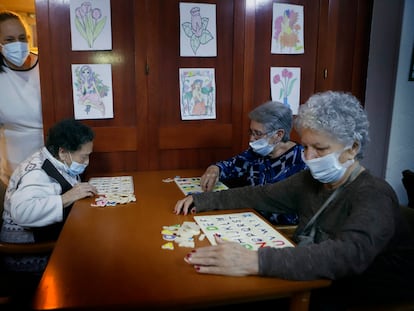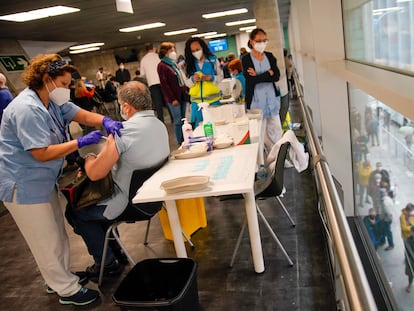Coronavirus in Spain: What restrictions can be expected after the state of alarm ends on May 9?
Experts predict that limits on social gatherings will remain in place, but say the exact measures will depend on the vaccination drive and the impact of new, more-contagious strains of the virus

The countdown to the end of the state of alarm on May 9 has begun. For the past six months, the emergency measure has given the country’s regional governments the power to introduce coronavirus restrictions that limit fundamental rights – such as nighttime curfews and perimetral lockdowns – without facing legal challenges in the courts. But the end of the state of alarm will not necessarily mean the end of coronavirus restrictions. Given that the incidence rate in Spain is rising – the 14-day cumulative number of cases per 100,000 inhabitants has jumped 20% in a week and now stands at 182 – epidemiologists believe that limits on social activity will need to remain in place if the country is to contain the pandemic.
None of the experts who spoke to EL PAÍS wanted to predict what the epidemiological situation in Spain will be like after May 9, arguing that this will largely depend on the progress of the Covid-19 vaccination drive and the impact of new, more-contagious variants of the virus. But given that Spain is entering a fourth wave and that there is still uncertainty over how increased social activity over the Easter vacations has affected contagion rates, even the most optimistic of the epidemiologists admitted that the outlook is not positive.
In May, it’s possible that we won’t have the intensity of the third wave, but there will be high incidence rates and measures will be requiredDaniel López-Acuña, former official for the World Health Organization
“I want to believe that the epidemiological situation will be better then than now,” said Alberto Infante, professor of the National Health School at the Carlos III Health Institute. “We will see rises this week and the next. The first week of May, [the incidence rate] will subside, but there will still be community transmission and contention measures will be needed.”
When the current state of alarm was approved in October last year, Spain was in the middle of a second wave and the figures were much worse than they are now: the 14-day cumulative number of cases per 100,000 inhabitants stood at 307 and there were around 2,800 Covid-19 patients in intensive care units (ICUs), with the ICU occupancy rate at 28%. The current incidence rate is half that number, while Covid-19 patients occupy 20% of all ICU beds. But it is difficult to compare the two situations as the spread of the virus is unpredictable and influenced by many factors. Back in October, no one was vaccinated against Covid-19 as the immunization drive did not begin until December 27. Now around three million people have received at least their first shot of the vaccine. But on the other hand, in October, the new, more-contagious strain of the virus first detected in the United Kingdom was not the dominant strain, while today it accounts for between 70% and 90% of cases in Spain.
“In May, it’s possible that we won’t have the intensity of the third wave, but there will be high incidence rates and measures will be required,” explained Daniel López-Acuña, a former official for the World Health Organization (WHO). The Spanish Health Ministry has recommended that regions where the 14-day cumulative number of cases per 100,000 inhabitants is above 150 suspend indoor dining, but this decision is ultimately up to the regional governments, which are in charge of managing the pandemic in their territories.
Curbing the incidence rate and easing the pressure on Spain’s hospitals is not an easy task. Thanks to restrictions introduced to stop the third wave, Spain was able to reduce the 14-day cumulative number of cases per 100,000 inhabitants from 900 in February to 127 in March. But this figure is still far from the government’s goal of lowering the incidence rate to 25, recommended by health authorities to keep the pandemic under control. In some regions, such as Madrid, which has the least strict restrictions, the incidence rate has not fallen below 200 since August last year.
Spanish Prime Minister Pedro Sánchez said last week that the government – which is headed by a coalition of the Socialist Party (PSOE) and junior partner Unidas Podemos – is working to ensure that it will “not be necessary” to extend the state of alarm, announcing that 10% of the adult population – five million people – will have received at least their first shot of the Covid-19 vaccine by the first week of May. But while Spain has nearly finished vaccinating the 80-and-over population with the first dose (only half have received both shots), the inoculation of other high-risk groups is lagging behind. Only 3% of people aged between 70 and 79 and 5% of those in the 60-to-69 age bracket have been given the two doses needed for full protection.
“If the [vaccination] campaign is boosted, we will be in a better situation,” said Infante. “But until we achieve herd immunity, we have to protect the most vulnerable. If we reach May 9 with a significant number of vulnerable people vaccinated, more than 80%, the clinical situation will be better.”
In October, the coronavirus strain first detected in the UK was not the dominant one, but now it accounts for between 70% and 90% of cases
Although the central government has said the vaccination campaign will accelerate with the arrival of more doses, some epidemiologists warn this may not be enough to flatten the curve.
“We don’t see that the vaccination drive will have a significant impact by May. There may be less pressure on the health system, but the reality is health authorities are trusting too much that the immunization drive can stop the waves,” said López-Acuña, who recommended that the current measures, such as the perimetral lockdown of regions and nighttime curfew, be kept in place until the end of summer, and the general rules on the use of face masks and social distancing until at least the end of the year.
The new variants of the coronavirus may also affect what restrictions are introduced. Although the strain first detected in the UK responds to Covid-19 vaccines, epidemiologists still don’t know whether the medications will be as effective against the variants detected in Brazil and South Africa or if these strains will spread further in Spain. “It seems that these two are not spreading much, but it will have to be reevaluated then [on May 9],” said Infante. “If they don’t give us a fright, we will be able to do more things, but there will have to continue to be restrictions on indoor spaces and nighttime activities must be carried out with great caution.”
The epidemiologists are also concerned that the end of the state of alarm will leave the regions in a legal limbo that will hurt the effort to control the pandemic. When the first state of alarm expired in June of last year, the attempt to pass the control of coronavirus restrictions to the regional governments led to a series of court cases, resulting in a number of sometimes contradictory rulings. The health experts fear that this situation could repeat itself from May, given that any limits on fundamental rights established by the regions require legal backing.
“Without a state of alarm, you are leaving the regions that have to apply these measures to the discretion of judges, you are leaving them unprotected,” warned Infante.
Current restrictions

English version by Melissa Kitson.
Tu suscripción se está usando en otro dispositivo
¿Quieres añadir otro usuario a tu suscripción?
Si continúas leyendo en este dispositivo, no se podrá leer en el otro.
FlechaTu suscripción se está usando en otro dispositivo y solo puedes acceder a EL PAÍS desde un dispositivo a la vez.
Si quieres compartir tu cuenta, cambia tu suscripción a la modalidad Premium, así podrás añadir otro usuario. Cada uno accederá con su propia cuenta de email, lo que os permitirá personalizar vuestra experiencia en EL PAÍS.
¿Tienes una suscripción de empresa? Accede aquí para contratar más cuentas.
En el caso de no saber quién está usando tu cuenta, te recomendamos cambiar tu contraseña aquí.
Si decides continuar compartiendo tu cuenta, este mensaje se mostrará en tu dispositivo y en el de la otra persona que está usando tu cuenta de forma indefinida, afectando a tu experiencia de lectura. Puedes consultar aquí los términos y condiciones de la suscripción digital.
More information
Últimas noticias
Trump claims peace in Ukraine is near, but Moscow suggests otherwise
A survivor’s account of the Interoceanic Train accident: ‘We were scared because of the speed on the curve’
The Interoceanic Train, the Mexican alternative to the Panama Canal
What is known about the Interoceanic Train derailment in Oaxaca
Most viewed
- Oona Chaplin: ‘I told James Cameron that I was living in a treehouse and starting a permaculture project with a friend’
- Reinhard Genzel, Nobel laureate in physics: ‘One-minute videos will never give you the truth’
- Why the price of coffee has skyrocketed: from Brazilian plantations to specialty coffee houses
- Pablo Escobar’s hippos: A serious environmental problem, 40 years on
- Chevy Chase, the beloved comedian who was a monster off camera: ‘Not everyone hated him, just the people who’ve worked with him’










































